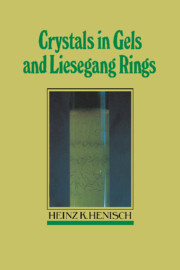2 - Gel structure and properties
Published online by Cambridge University Press: 06 January 2010
Summary
Gel preparation and properties
Although it is true that good crystals can occasionally be grown in substances that are not normally classified as gels, the general observation is that gels and, in particular, silica gels, are the best and most versatile growth media. Their preparation, structure, and properties therefore deserve attention. At the same time, it is useful to note that no clean-cut demarcation lines between gels, sols, colloidal suspensions, and pastes have ever been established. Standard descriptions of these materials are certainly available but they are not nearly as crisp as one would wish, and many practical substances must be regarded as borderline cases. Thus, for instance, Lloyd (1926) wrote disarmingly that ‘a gel is easier to recognize than to define’, and even 23 years later the best available characterization referred to a gel as ‘a two-component system of a semi-solid nature, rich in liquid’ (Alexander and Johnson, 1949). No one is likely to entertain illusions about the rigor of such a definition.
The materials which are ordinarily called gels include not only silica gel (e.g. as usually grown from sodium metasilicate solution), but also agar (a carbohydrate polymer derived from seaweed), gelatin (a substance closely related to proteins), soft soaps (potassium salts of higher fatty acids), a variety of oleates and stearates, polyvinyl alcohol, various hydroxides in water, and even (water-insoluble) tetraethoxysilane in the presence of electrolytes and co-solvents (e.g. methanol) or surface-active agents (Caslavska and Gron, 1984).
- Type
- Chapter
- Information
- Crystals in Gels and Liesegang Rings , pp. 29 - 47Publisher: Cambridge University PressPrint publication year: 1988

